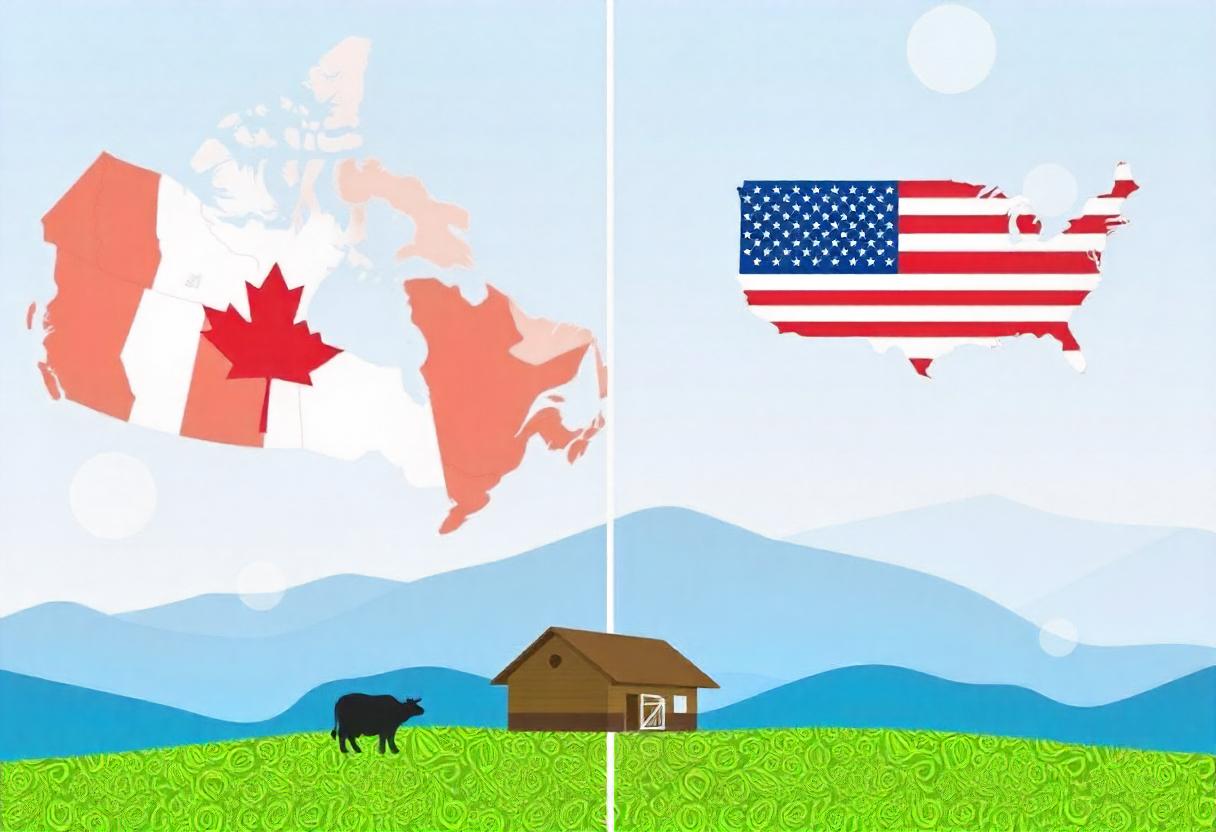
Farming is a cornerstone of both the Canadian and American economies, each country having its unique agricultural landscape shaped by geography, climate, policy, and market dynamics. While both nations are major agricultural producers and exporters, there are notable differences in their farming practices, profitability, and industry structure. This article provides a detailed comparison of farming in Canada and the USA, highlighting key differences and similarities in various aspects of agriculture.
Overview of Agriculture in Canada and the USA
Canada:
- Economic Contribution: Agriculture contributes significantly to the Canadian economy, with the agricultural sector generating over $140 billion annually in GDP. The industry supports about 2% of the workforce, with a focus on grain and oilseed production, livestock, and dairy farming.
- Land Use: Approximately 7% of Canada’s land area is used for agriculture, predominantly in the Prairie Provinces (Alberta, Saskatchewan, Manitoba). These regions are known for their expansive grain and oilseed farms.
- Major Products: Canada is a leading exporter of wheat, canola, barley, and pulse crops. It also produces significant amounts of beef, pork, and dairy products.
USA:
- Economic Contribution: The agricultural sector in the USA contributes about $1.2 trillion annually to the GDP, with agriculture and related industries supporting roughly 11% of the workforce. The USA is a major global producer and exporter of a wide variety of agricultural products.
- Land Use: About 44% of the land area in the USA is used for agriculture, with major farming regions including the Midwest (Corn Belt), the South (Cotton Belt), and the West (Fruit and Vegetable Belt).
- Major Products: The USA leads in the production of corn, soybeans, wheat, and cotton, and is also a major producer of beef, poultry, dairy products, and fruits.
Key Differences in Farming Practices
1. Farm Size and Structure
- Canada: Canadian farms tend to be larger in terms of land area compared to U.S. farms, especially in the Prairie Provinces. However, they often have fewer total farms due to the concentration of land into large-scale operations. The average size of a Canadian farm is about 800 acres.
- USA: U.S. farms are generally smaller in land area compared to Canadian farms but have a larger total number of farms. The average size of a U.S. farm is about 440 acres. The U.S. also has a more diverse range of farm sizes, from small family farms to large agribusinesses.
2. Crop and Livestock Production
- Canada: Canada’s agricultural production is heavily focused on grains and oilseeds, with significant outputs of wheat, canola, and barley. Livestock farming is also important, particularly beef and pork. Dairy farming is concentrated in Quebec and Ontario.
- USA: The USA has a more diversified agricultural sector with significant production of corn, soybeans, and wheat. It is also a leading producer of cotton and fruits. The U.S. has a strong livestock sector, including beef, poultry, and pork, with major dairy operations spread across several states.
3. Climate and Growing Conditions
- Canada: The cold climate in Canada limits the growing season and influences the types of crops that can be cultivated. The Prairie Provinces benefit from a continental climate with warm summers ideal for grain production. However, shorter growing seasons and cold winters can pose challenges.
- USA: The USA’s diverse climate zones allow for a wide range of crops and farming practices. The Midwest, with its fertile soil and favorable climate, is ideal for corn and soybean production. The South supports cotton and rice, while the West Coast is known for fruits and vegetables.
Economic and Policy Factors
1. Government Support and Subsidies
- Canada: Canadian farmers benefit from various government programs and subsidies, including support for crop insurance, disaster relief, and sustainability initiatives. The Canadian Agricultural Partnership (CAP) provides funding for farm innovation, environmental sustainability, and market access.
- USA: The U.S. agricultural sector receives substantial government support through the Farm Bill, which provides subsidies for crops, livestock, and conservation programs. The U.S. also offers crop insurance, disaster assistance, and funding for research and development.
2. Trade and Market Access
- Canada: As a member of the United States-Mexico-Canada Agreement (USMCA), Canada has access to a significant market for its agricultural products. Trade policies and international agreements are crucial for Canadian farmers, given the country’s reliance on exports.
- USA: The U.S. is a major player in global agricultural trade, with significant exports to various countries. Trade agreements and policies, including those with China and other trading partners, impact U.S. farmers’ profitability and market access.
Challenges and Future Trends
1. Climate Change and Sustainability
Both Canada and the USA face challenges related to climate change, including extreme weather events, changing growing conditions, and environmental sustainability. Both countries are investing in technologies and practices to improve resilience and reduce the environmental impact of farming.
2. Technological Advancements
Advancements in technology, such as precision agriculture, automation, and data analytics, are transforming farming practices in both countries. These technologies improve efficiency, reduce costs, and enhance productivity, offering new opportunities for farmers.
3. Consumer Preferences and Market Trends
Consumer preferences for organic, locally produced, and sustainably sourced foods are influencing agricultural practices in both Canada and the USA. Farmers are adapting to these trends by diversifying their products and adopting more sustainable practices.
Conclusion
Farming in Canada and the USA presents unique opportunities and challenges, shaped by factors such as farm size, crop and livestock production, climate, and government policies. While both countries are major agricultural producers with substantial contributions to the global food supply, differences in farming practices, market dynamics, and support systems reflect their distinct agricultural landscapes.
As both nations navigate the evolving agricultural landscape, including challenges related to climate change and technological advancements, the future of farming will depend on their ability to adapt, innovate, and meet changing consumer demands. By leveraging their strengths and addressing their respective challenges, Canadian and American farmers can continue to play a vital role in feeding the world and sustaining their economies.